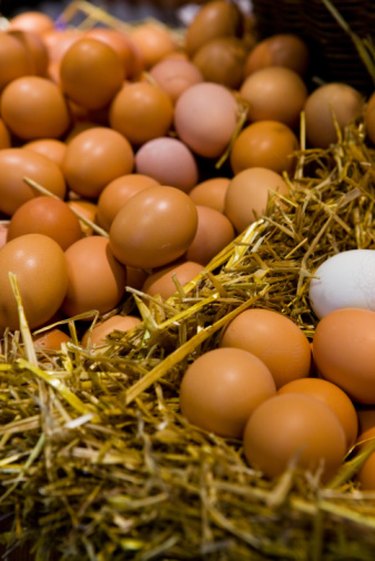
In nature, plants flourish in the type of soil that agrees with them and are rarely found in areas where the soil is not to their liking. In the garden, however, plants are subjected to the local conditions, and few gardens have perfect soil. The nutrient content of the soil can be easily improved by adding a variety of amendments. Kitchen scraps, such as egg shells, can be used to raise the pH of the surrounding soil, improving the condition of overly-acidic planting sites. Additionally, using a solution made from boiled egg shells can provide plants with vital nutrients, such as calcium and magnesium.
Nutrition
Video of the Day
Many gardeners must cope with extremes of pH that reduce nutrient availability. Soils that have a pH of less than 6.0 are considered acidic. Lime is generally used to raise the pH of acidic soils and make the garden more hospitable to a wider variety of plants. The active ingredient in gardening lime is calcium carbonate, or CaCO3. Egg shells are a natural source of calcium carbonate, and as a result, solutions made from egg shells are alkaline and will effectively neutralize any acid they come into contact with. In addition to being a rich source of calcium, eggshells also contain nitrogen and trace amounts of magnesium, phosphorous and collagen, all of which are essential for healthy plant growth.
Video of the Day
Directions
To make an egg shell solution, place the shells from 20 eggs in a large pan and cover them with 1 gallon of water. Bring the water to a rolling boil, then set the mixture aside and let it cool for 24 hours. Pour the solution through a strainer to remove any large pieces of shell, then transfer the liquid to an air tight container and store it in a cool, dark place. Alternatively, fill a 1-gallon jar with water and add egg shells to it as they become available. Wait at least one month from the start date to remove any of the liquid as this will give the water time to dissolve the shells, removing the essential nutrients in the process.
Use
Apply egg shell water to both indoor and outdoor plants by pouring it directly to the soil surrounding the base of the plant. Weekly applications of egg water will give nearby flora a calcium boost and will reduce the acidity of the soil, but the shift in pH is a temporary one. To maintain a neutral pH egg shell water needs to be routinely applied for the length of the growing season. For light foliar feedings, mix 1 cup of egg shell water into 1 quart of fresh water. Transfer the solution to a plastic spray bottle and spritz it evenly over the plant's leaves. This type of feeding allows the plant to have immediate access to the nutrients as it effectively bypasses the roots.
Considerations
Although regular applications of egg shell water can remedy certain deficiencies in the soil, it is not a nutrient-rich fertilizer. Many unfortunate gardening situations can be easily resolved by incorporating organic material into the soil. Organic matter such as grass clippings, shredded leaves, rotted animal manure and mature compost improves the condition of the soil by adding essential nutrients and encouraging the presence of beneficial insects and microorganisms.